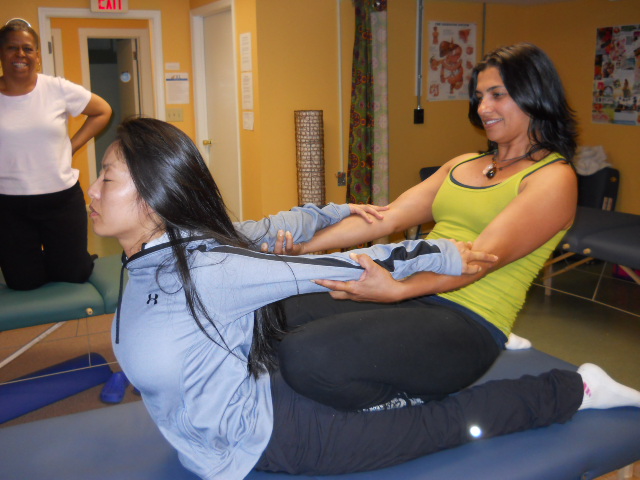Fundamentals of Stretching

- Stretching is essentially a mechanical manual/movement therapy that is aimed at making a soft tissue longer.
- The direct goal of stretching is to increase joint flexibility / range of motion (ROM).
- If pain if present as a result of the contracted, tight, hypertonic, locked, overly facilitated tissues, then decreasing pain can be another goal.

Oblique plane neck stretch. Permission Joseph E. Muscolino. Advanced Treatment Techniques for the Manual Therapist: Neck (LWW, 2013)
Lengthen / Do opposite of target muscle’s joint actions:
- When looking to stretch a muscle (muscle-tendon unit, myofascial unit), the approach is fairly straight forward: bring the attachments of the muscle away from each other.
- This can be done by simply moving the client into the joint actions that are “opposite” of the actions of the target muscle that you are looking to stretch.
Neural Inhibition can be added:
- Beyond the mechanical aspect of stretching, when stretching musculature, we can also add a neural inhibition to the tone of the muscle.
- This is done by working with nervous system reflexes
- Reciprocal Inhibition (RI)
- Golgi Tendon Organ (GTO) reflex.
Indications / Contraindications for Stretching
Indication for stretching:
- Hypomobility
- Tight, hypertonic, overly facilitated, locked musculature
- Fascial adhesions
- Fascial contraction
Contraindication / Precaution for stretching:
- Hypermobility / Unstable tissue

Permission Joseph E. Muscolino. Manual Therapy for the Low Back and Pelvis – A Clinical Orthopedic Approach (LWW, 2015)
What does stretching work on?
- Muscle tone
- Fascial adhesions
- Fascial contraction
Muscle tone:
- The term muscle tone refers to the baseline tone of the muscle. In other words, its tone at rest.
- The term muscle memory is often used to describe the baseline tone of a muscle.
- Muscle memory actually resides in the nervous system.
- A muscle’s baseline tone is determined by muscle spindle activity, which is determined by the central nervous system (lower gamma motor neurons from the spinal cord that are controlled by upper gamma motor neurons from subconscious regions of the brain).
Fibrous adhesions:
- Fibrous adhesions (known as “fuzz” by Gil Hedley) refer to fascial collagen / scar tissue buildup within soft tissues.
Fascial contraction:
- Fascia contraction refers to the fact that fascia has the ability to contract.
- This contraction ability is not directly controlled by the nervous system.
- It is not consciously directed.
- It is not immediate.
(Click here for the blog post article: Stretching Reduces Cancer Tumor Growth in a Study with Mice.)
Digital COMT
Did you know that Digital COMT (Digital Clinical Orthopedic Manual Therapy), Dr. Joe Muscolino’s continuing education video streaming subscription service for massage therapists (and all manual therapists and movement professionals), has at present (October of 2018) more than 1,000 video lessons on manual therapy continuing education, including entire folders on stretching, joint mobilization, and massage. And we add seven (7) new videos lessons each and every week! And nothing ever goes away. There are also folders on Pathomechanics and Anatomy and Physiology, including an entire folder on Cadaver Anatomy… and many, many more on other manual and movement therapy assessment and treatment techniques? Click here for more information.


